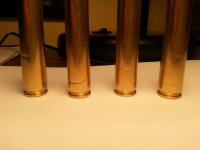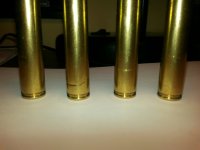Hi folks,
New to the forum here. I just purchased a bunch of new toys, got rid of some old guns I inherited to buy my .270win T3 Laminate and Blackhawk 3-15x50 ffp scope. I'm excited to get into long range shooting and I need some info. Any help would be greatly appreciated as I have not found much info online for these 3 issues I have.
I purchased the Lee Collet die set (2 dies) to reload .270win, Hornady 130 gr SSTs and new unfired Winchester brass. I am using my dad's old Bonanza press model 68 (not the coax now made by forster).
First of all, is it normal for virgin brass to have defects? I have one casing that has a gouge/crack right THROUGH a neck (I can see light go through it). Seven other cartridges have what look like gouges or heavy indented scratches. One of these gouges wraps around the base of the cartridge about half an inch from the extractor groove. One of these has a dent in the shoulder, which I would guess is probably safe, but I'm gonna leave it aside as well and send them all back to Winchester for inspection. I have some pictures posted at the bottom of this post.
Second question, (searched and couldn't find and answere on this one) when I size the necks using the Lee collet sizer, I was under the impression I could somewhat seat bullets in by hand, but the necks are tight and I can only seat the boat tail base of the bullet about 1/8" then it gets pretty tight. All I've been able to find is info where most guys find the case necks are too loose, and can therefor sand the mandrel down .001" to make the necks a bit tighter. Just wondering if this could cause problems when seating bullets (ie. if the bullet is off to the side when going up in the die will that cause it to seat unevenly?).
Third question: My Frankford Arsenal DS-750 scale seems to "drift" by about .2 grains and I'm not sure how picky I should be. I do expect on shooting tight groups and long ranges.
Any advice is greatly appreciated!
-Alex in Toronto
New to the forum here. I just purchased a bunch of new toys, got rid of some old guns I inherited to buy my .270win T3 Laminate and Blackhawk 3-15x50 ffp scope. I'm excited to get into long range shooting and I need some info. Any help would be greatly appreciated as I have not found much info online for these 3 issues I have.
I purchased the Lee Collet die set (2 dies) to reload .270win, Hornady 130 gr SSTs and new unfired Winchester brass. I am using my dad's old Bonanza press model 68 (not the coax now made by forster).
First of all, is it normal for virgin brass to have defects? I have one casing that has a gouge/crack right THROUGH a neck (I can see light go through it). Seven other cartridges have what look like gouges or heavy indented scratches. One of these gouges wraps around the base of the cartridge about half an inch from the extractor groove. One of these has a dent in the shoulder, which I would guess is probably safe, but I'm gonna leave it aside as well and send them all back to Winchester for inspection. I have some pictures posted at the bottom of this post.
Second question, (searched and couldn't find and answere on this one) when I size the necks using the Lee collet sizer, I was under the impression I could somewhat seat bullets in by hand, but the necks are tight and I can only seat the boat tail base of the bullet about 1/8" then it gets pretty tight. All I've been able to find is info where most guys find the case necks are too loose, and can therefor sand the mandrel down .001" to make the necks a bit tighter. Just wondering if this could cause problems when seating bullets (ie. if the bullet is off to the side when going up in the die will that cause it to seat unevenly?).
Third question: My Frankford Arsenal DS-750 scale seems to "drift" by about .2 grains and I'm not sure how picky I should be. I do expect on shooting tight groups and long ranges.
Any advice is greatly appreciated!
-Alex in Toronto
Attachments
Last edited:



